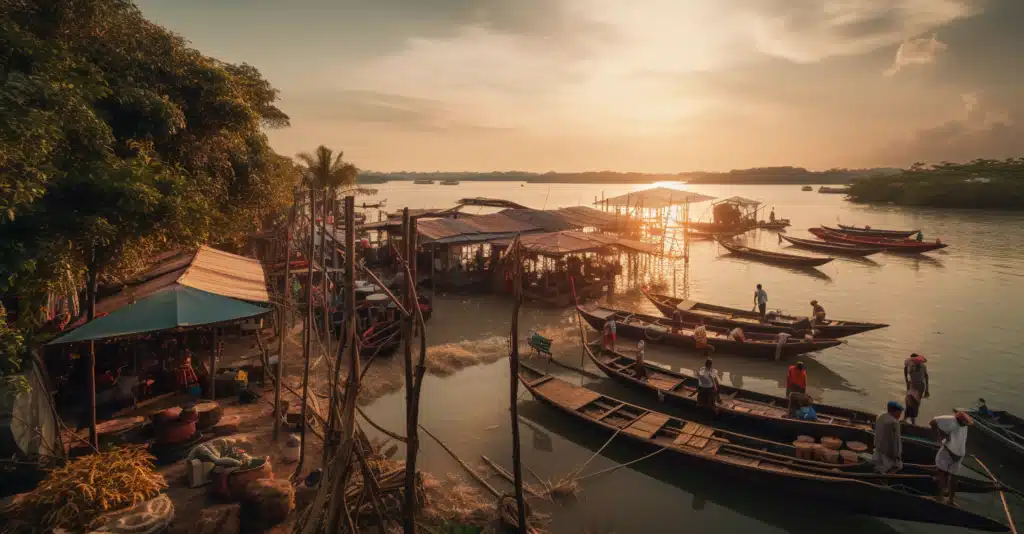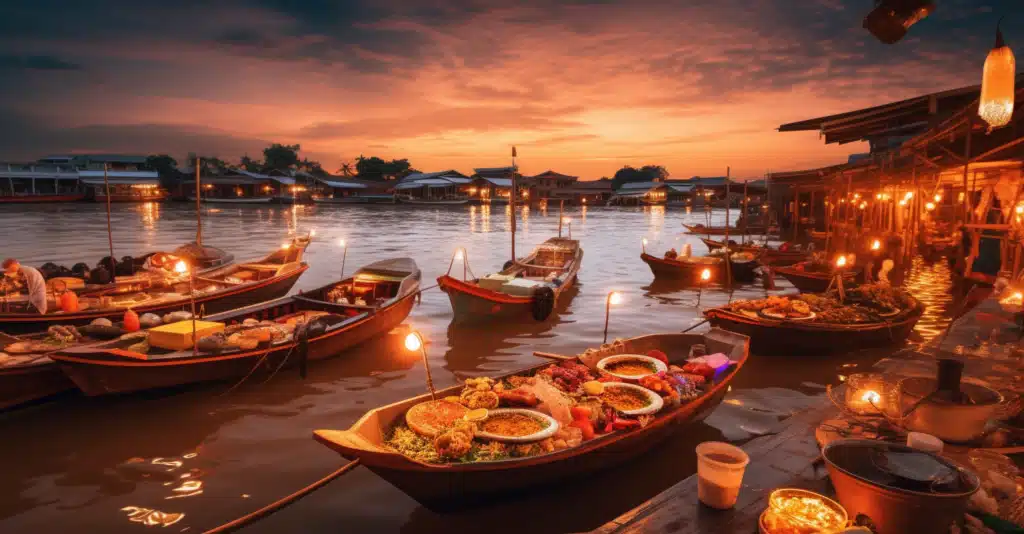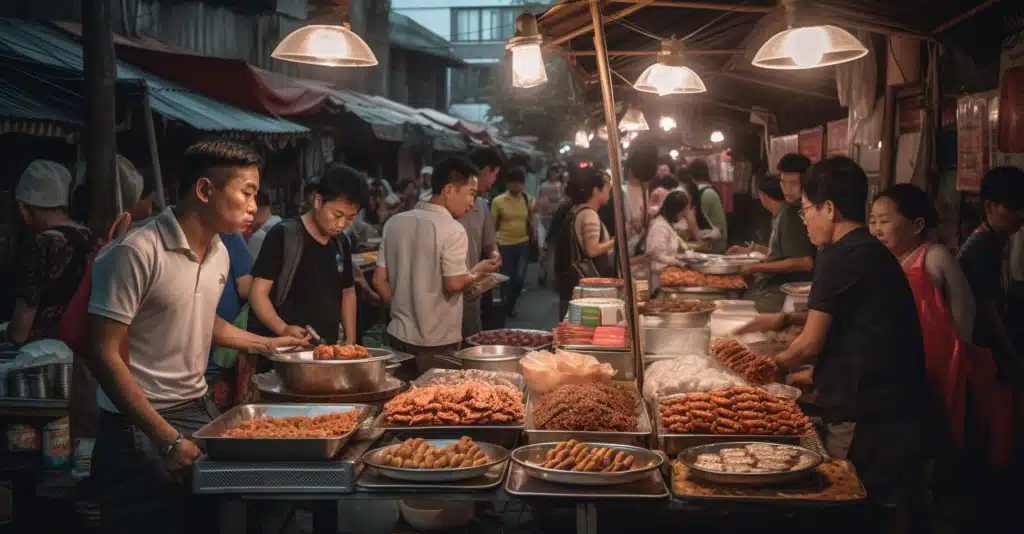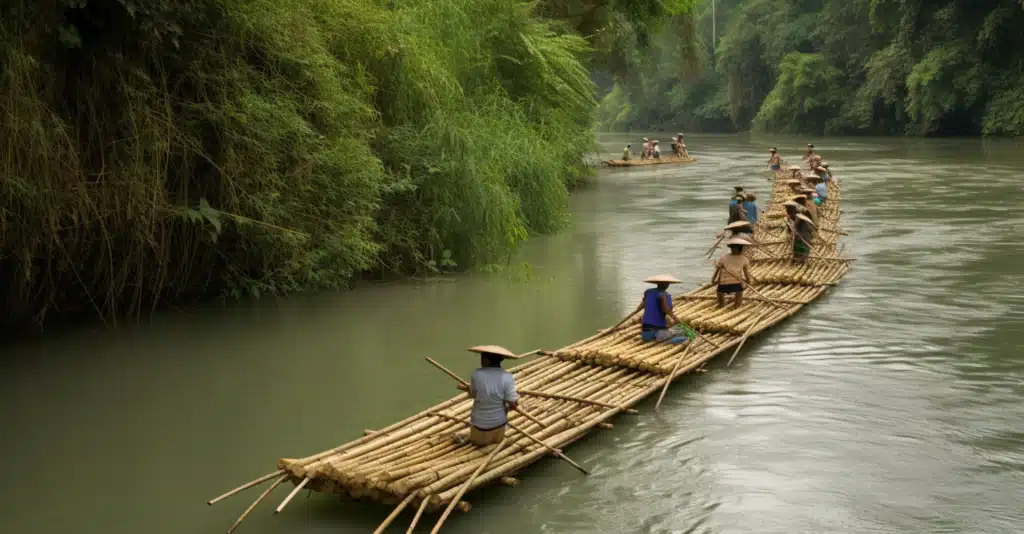Email: - The selected trip. Good deals revealed.
Bangkok may be a city that never sleeps (except perhaps during the post-Pad Thai siesta), but you only have to escape a handful of kilometres to feel the air change. You leave behind the satay-scented traffic jams to follow roads lined with coconut palms, where temples rise up between fields of salt. Here, each province is like a turbulent little sister to the capital: Samut Sakhon serves you the sea on a platter, Samut Songkhram surprises you with trains that run through the markets as if nothing had happened, Ratchaburi takes you on a journey through limestone hills and shadow theatre, Phetchaburi and Hua Hin show off their palaces and sweet desserts, and Kanchanaburi whispers stories that the river has never forgotten. This itinerary is a bit like opening a treasure chest: you never know whether you'll come across a firefly, a dolphin or a palm curry. And that's the magic of it all.
Leaving Bangkok for Samut Sakhon means switching from the din of car horns to the clatter of crab baskets. The Mahachai market, a rustling giant where prawns vie with squid for the limelight, is as much a feast for the eyes as it is for the palate. The scent of grilled fish mingles with the laughter of the traders, and you'll find yourself dreaming of a seaside kitchen overlooking the Tha Chin River. In the village of Ban Don Kai Dee, Benjarong porcelain gleams like a rainbow frozen in clay, and the guesthouses welcome you with steaming jasmine tea. Further on, the wooden Wat Yai Chom Prasat still tells the story of the Ayutthaya era in its patinated frescoes. On the water, the mangroves rustle with life and, if you're lucky, an Irrawaddy dolphin will greet you with a discreet breath. Between September and December, Bryde's whales pass by, peaceful giants that glide beneath the surface like silvery shadows. Here, the sea is alive, and time moves to the rhythm of the ebb and flow of the tides.


At Samut Songkhram, the train always takes priority - even over vegetables. At the Mae Klong railway market, the awnings are folded like hats being taken off in front of the king, while the train pulls away to within centimetres of the baskets of mangoes. In Amphawa, the floating market dances to the rhythm of the paddles, each boat overflowing with grilled prawns, golden sweets and colourful souvenirs. When night falls, another spectacle begins: thousands of fireflies light up the banks like a tropical Christmas tree. The floating market at Tha Kha is more discreet, enveloping you in the scent of fresh herbs and the murmur of slow conversations. King Rama II Memorial Park takes you back to a time when traditional houses stood like still ships in the middle of gardens. And if your feet are in need of sand, Don Hoi Lot beach offers razor clam hunting at low tide, punctuated by generous plates in nearby restaurants.
In Ratchaburi, you can enjoy the sparkle of fruit on the water at Damnoen Saduak, the country's most famous floating market, where the boats clash in a masterful choreography. For a more tranquil experience, the Lau Tak Lak market awaits you on the other side of the bridge. The Khao Ngu Stone Park raises its limestone mountains like giant guardians, sheltering troglodyte temples and ancient frescoes. At the National Museum, the ceramics tell of the patient gestures of the hands of yesteryear, while at Photharam, the wooden houses retain the scent of rain and dust. Wat Khanon Nang Yai preserves the art of shadow puppetry: every Saturday morning, the sculpted silhouettes come to life in the hands of schoolchildren, projecting the stories of the Ramakien onto the fabric screen. At Suan Phueng, the lush green hills take on an almost European air, ideal for a breath of fresh air before heading to Bat Cave, where thousands of bats swoop down at dusk, drawing moving arabesques in the sky.
Between Phetchaburi and Hua Hin, the sea serves as a backdrop to a royal past. On the hill, Phra Nakhon Khiri blends Thai, Chinese and European architecture in a panorama that encompasses the city and the plains. Further down, the palace of Marukhathaiyawan, all in blond teak, exudes the gentleness of an eternal summer. Kaeng Krachan National Park unfolds deep forests, waterfalls and caves like a life-size catalogue of tropical biodiversity. The Pala-U waterfall offers natural pools for a swim in the heart of the jungle, and the Wildlife Friends Foundation Thailand reminds us that wildlife is not a decoration, but a living heritage to be protected. In Phetchaburi, the title of "city of gastronomy" can be defended with melting khanom mo gaeng and fragrant kaeng hua nod, tasted in the riverside market to the rhythm of the locals' conversations.


Kanchanaburi is not a province to be rushed through. The bridge over the River Kwai, with its worn crossbeams and black arches, recounts the memory of the workers and prisoners who left their strength there. At the JEATH Museum and the war cemetery, silence hangs like a low sky. The Hellfire Pass Memorial Museum, in the middle of the jungle, offers a trail where every step seems to resonate with the voices of the past. But Kanchanaburi is also the coolness of Erawan National Park, where seven levels of emerald-green waterfalls invite you to hike and swim. Further afield, Sai Yok Park opens out onto the River Kwai for boat trips, bamboo rafting and respectful encounters with elephants. Between mountains, rivers and temples, the province combines memory and beauty with a rare intensity.
Around Bangkok, there are really no "small" excursions: each diversions takes you into a different world, whether it's a floating market that smells of toasted coconuts, a palace facing the sea, a rustling jungle where you can make out the silhouette of an elephant, or a river that still carries the memories of mankind. It's an itinerary that can be travelled not just in kilometres, but with the senses alert. You can take in the smell of curry, the murmur of voices in the markets, the sunsets over the rice paddies, and the stories told by the locals over a cup of tea. So the next time Bangkok seems too big or too noisy, remember: just hop on the first train, bus or boat and you'll discover that the adventure begins long before the city's borders.
See also our mini-guide to Bangkok to find out more about the destination.
How about turning your dreams into reality? Discover our exceptional holidays to experience for real.
→ See all offersLorem ipsum dolor sit amet, consectetur adipiscing elit. Ut elit tellus, luctus nec ullamcorper mattis, pulvinar dapibus leo.
Email: is an innovative platform that combines communication and resale of products. Take advantage of discounted hotel nights or other services, and unique marketing communication.
Thanks to our Incomparable model, we allow professionals to benefit from increased visibility while enabling travelers to access exceptional offers.
© 2024 Breeziful. All rights reserved.
Geneva Business Directory: VAT number CHE-423.992.781
Find Breeziful Travel in
Tourism directory - Travel agency